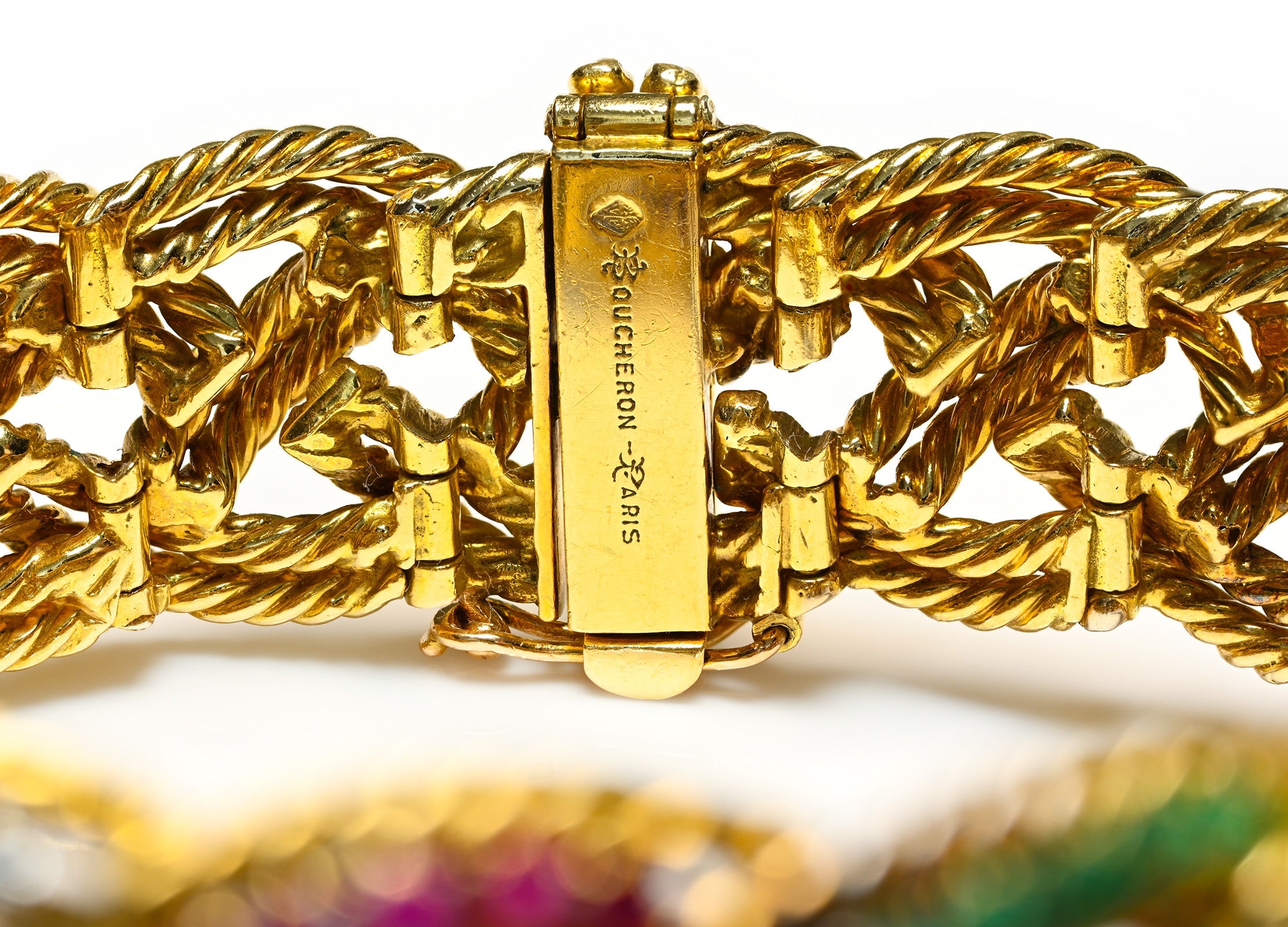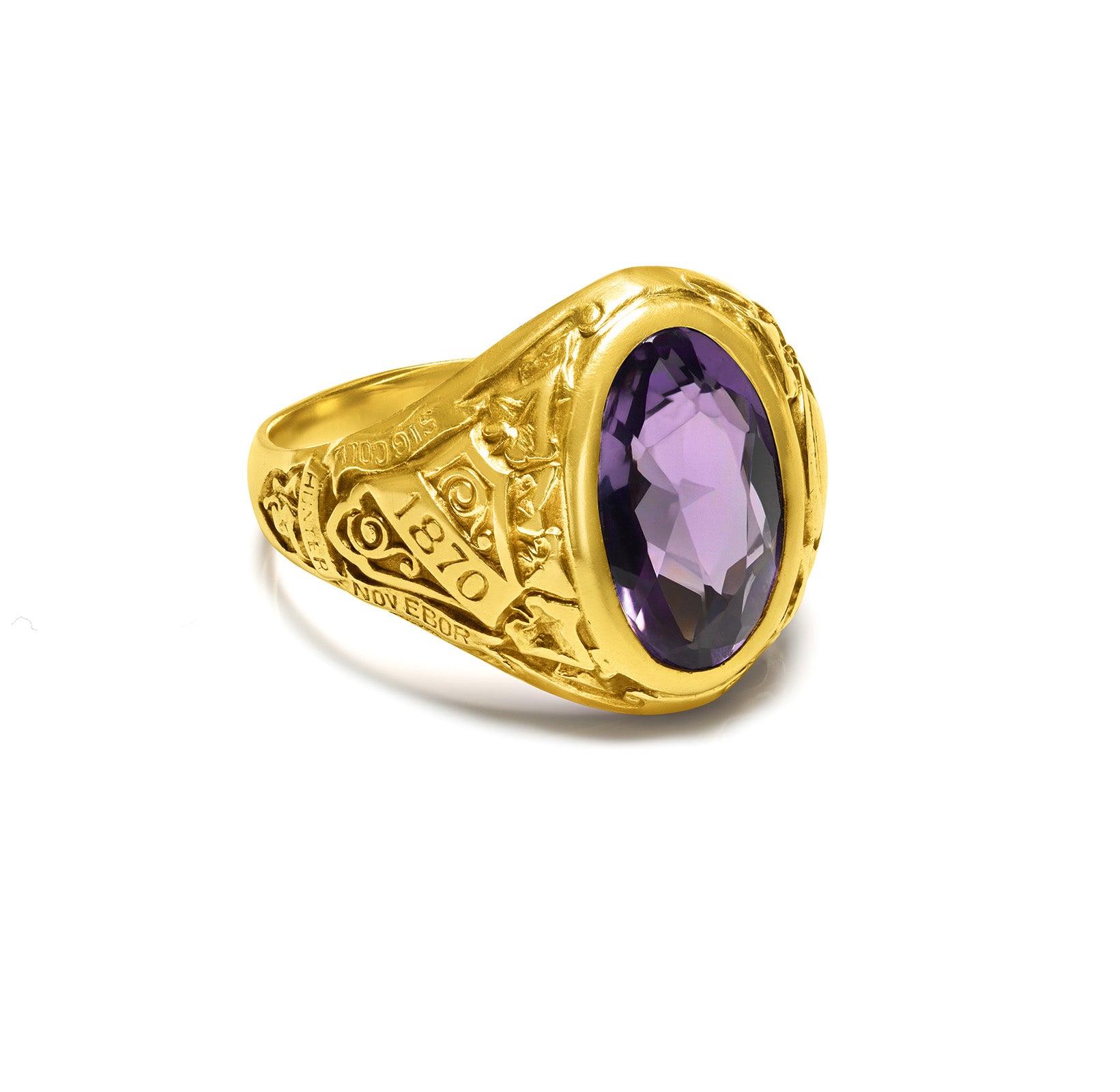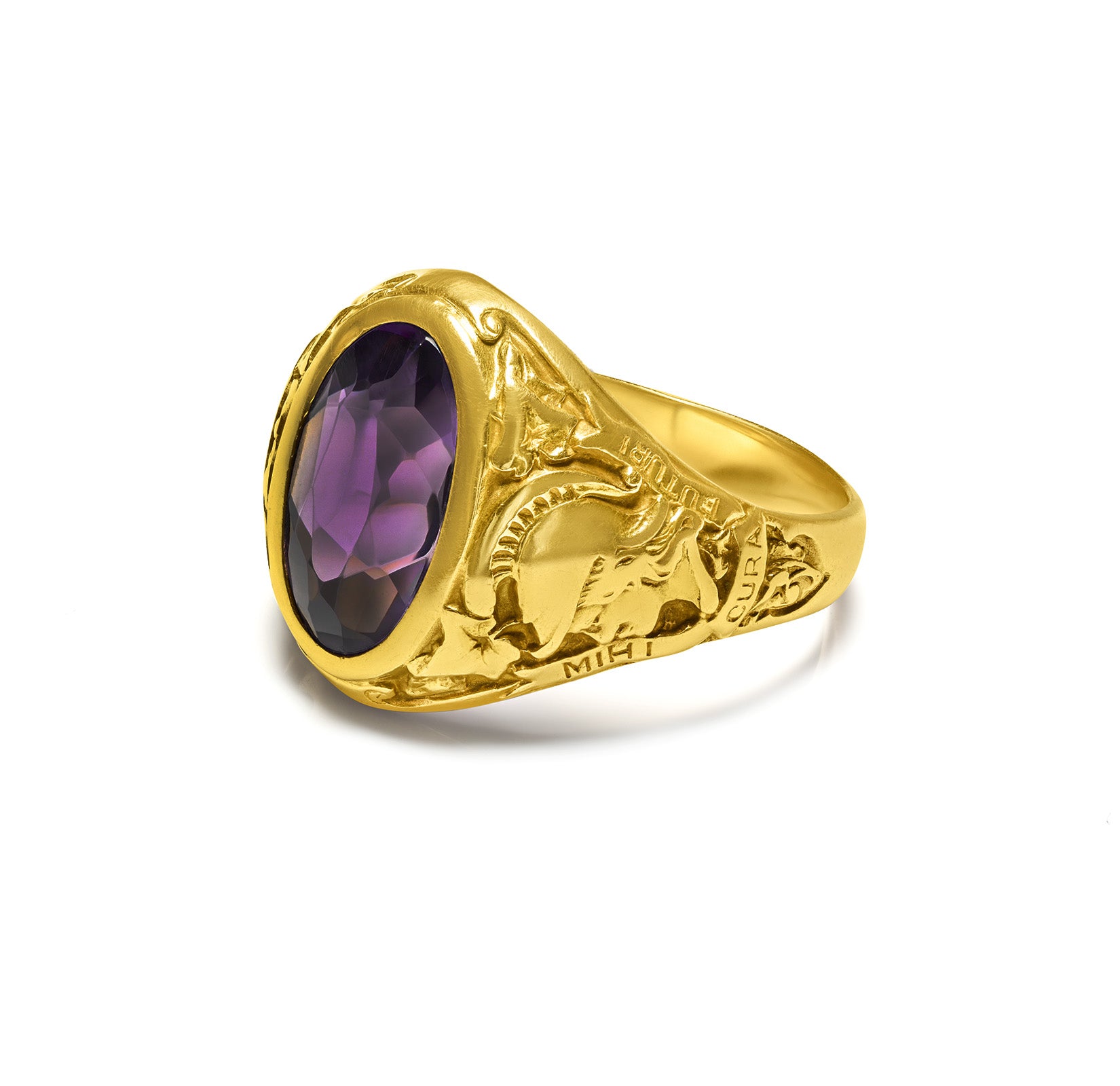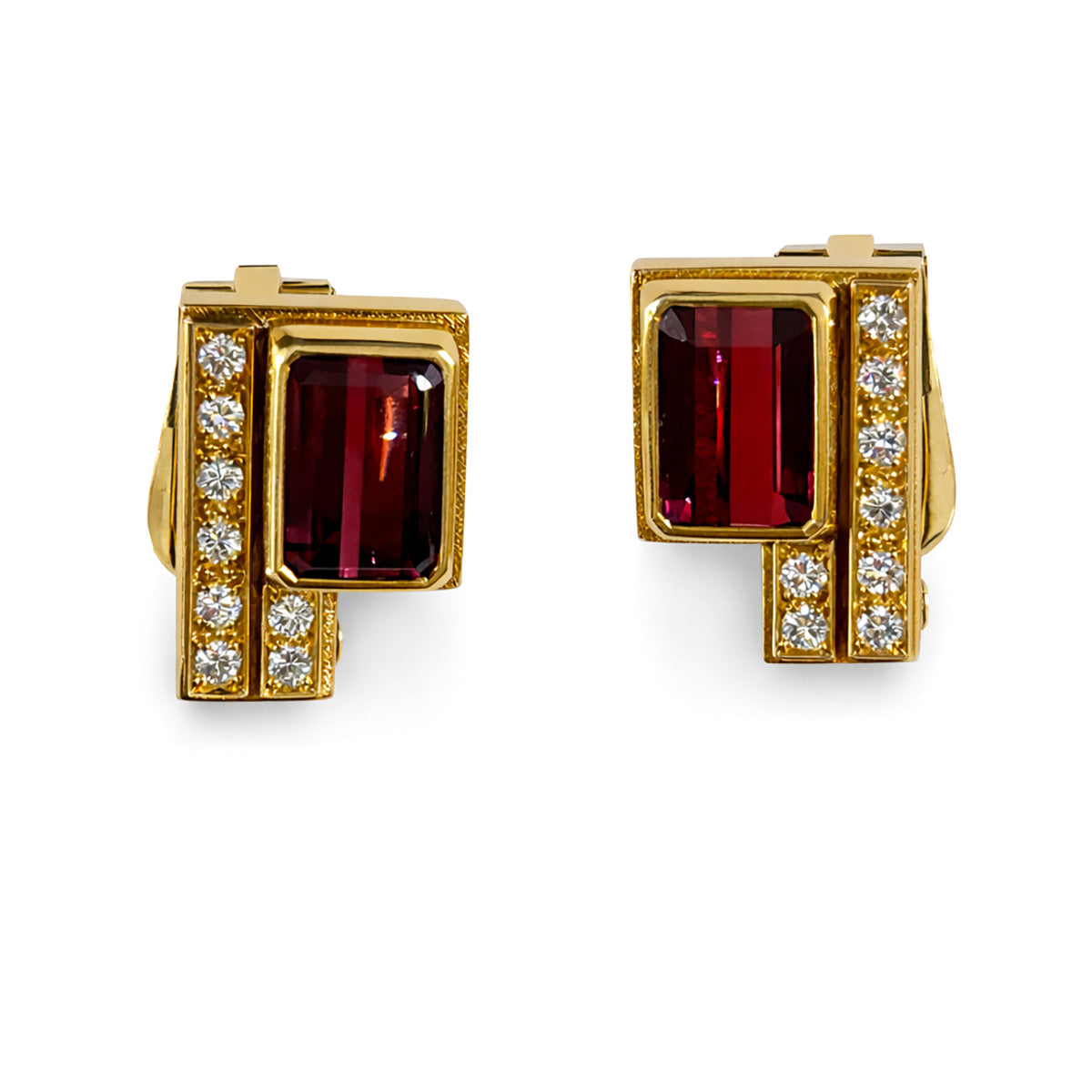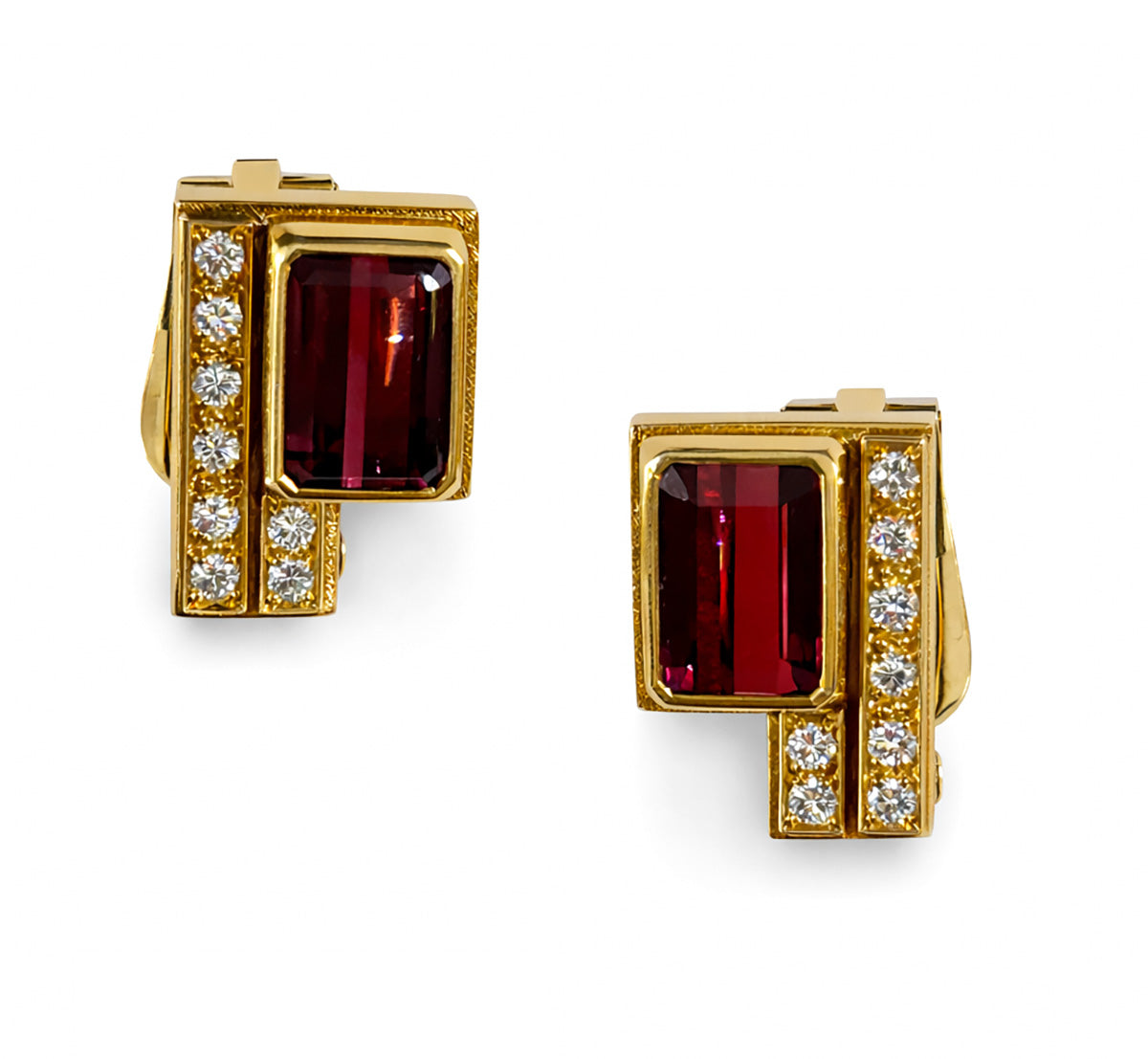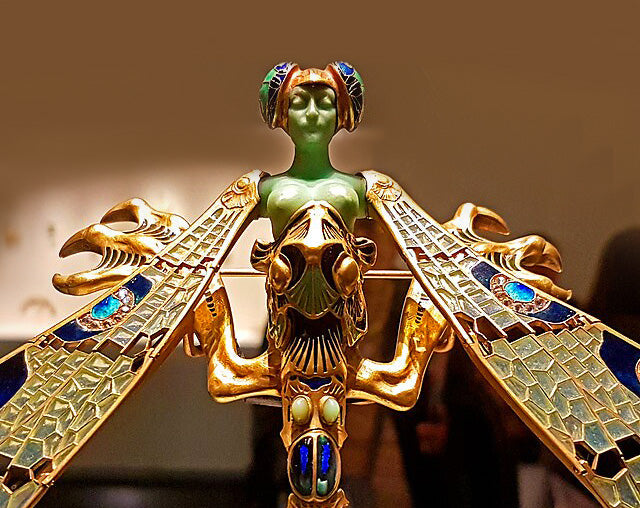
The Rise of Art Nouveau Jewelry
At the turn of the twentieth century, jewelry underwent a significant transformation as designers embraced a vibrant, new aesthetic. This period marked the birth of flamboyant and fantastical designs, characterized by sensuous forms, dramatic imagery, and rich poetic symbolism.
Born in Europe, the Art Nouveau style was not merely a stylistic shift, but a reaction to growing industrialization, the dominance of historical styles, and the perceived "tyranny of the diamond" as the centerpiece of jewelry design. These new creations were part of an international artistic movement that sought to break away from conventional norms and reinvigorate the world of design.
Art Nouveau jewelry was more than just adornment—it was a celebration of the spiritual and emotional depths of human creativity, according to author Yvonne Markovitz.

Photo Credit: Wikipedia - Ángel M. Felicísimo from Mérida, España
The Influence of Art Nouveau
As Markovitz explains in her book Imperishable Beauty: Art Nouveau Jewelry, originating in France and Belgium, Art Nouveau quickly spread across Europe, extending its influence as far as the Americas and Russia. Artists who embraced this movement sought to introduce a decorative style that rejected the rigid historicism of the past, instead favoring sinuous, asymmetrical lines and organic forms that mirrored the beauty of nature.
The artists and jewelers working in this style were part of the avant-garde, unified by their desire to experiment with new forms. Many of these creators had backgrounds in graphic arts, sculpture, and metalwork, and their works exhibited a fluidity and boldness that was unparalleled in the more conservative art circles of the time.

Source: Wikipedia - Philippe Wolfers
The Role of Symbolism and Pre-Raphaelite Inspiration
Art Nouveau jewelry was heavily influenced by earlier artistic movements, most notably the Pre-Raphaelite Brotherhood and Symbolism. In the mid-nineteenth century, the Pre-Raphaelites, a group of English poets, painters, and critics, sought to redefine art by rejecting the industrial, mechanistic realism promoted by the Royal Academy.
Their ideals resonated with those in the Art Nouveau movement, who also sought to break down the distinctions between fine and applied art. This holistic approach was advocated by figures like the British critic John Ruskin, a key supporter of the Pre-Raphaelites.
Gothic Revival and Symbolist Art
Another key influence on Art Nouveau was the Gothic Revival, which had taken root in Europe centuries earlier, particularly through religious architecture. Ruskin, an admirer of medieval art, championed this revival for its emotional depth and spiritual resonance. Gothic elements, such as pointed arches and ribbed vaults, were seen as evocative of a more romantic and meaningful past, and this ethos found its way into the organic, flowing lines of Art Nouveau jewelry.
Furthermore, the Symbolist movement of the late nineteenth century had a profound impact on Art Nouveau. Symbolist poets and artists rejected the scientific objectivism of Impressionism, instead emphasizing emotion, mysticism, and subjective reality in their work. This approach aligned with the principles of Art Nouveau, which sought to infuse art with deeper meaning and eschew rigid realism in favor of more fluid, dreamlike forms.

Source: Wikipedia by Saiko
Rococo Revival and the Whiplash Line
Art Nouveau also borrowed from earlier European design traditions, most notably the Rococo style. The Rococo period, with its emphasis on curving, delicate forms and natural motifs, resonated with Art Nouveau artists who sought to contrast their work with the excesses of Victorian design.
Orientalism in Art Nouveau Jewelry
Art Nouveau emerged from the Orientalist movement and shared several characteristics with it. Beginning around 1890 and lasting until 1910, this style developed as a reaction against Neoclassicism. Although it influenced fine arts, its most significant impact was on the decorative arts, particularly interior design and jewelry.

Source: Musee Lalique
According to Marina MacLatchie, jewelry became an ideal medium for exploring the new aesthetic. A hallmark of Art Nouveau is the use of the "whiplash line," a flowing, curvilinear motif that appears in nearly all Art Nouveau objects. These sinuous lines gave compositions an organic sense of movement.
In her essay Foreign Fantasies: Fabricating the Exotic Other in Art Nouveau Jewelry, MacLatchie highlights perhaps the most famous example—René Lalique's Peacock Pectoral—where the swirling gold lines of the peacock's tail feathers illustrate the whiplash motif (figure 4).

Source: Wikipedia - José Luiz Bernardes Ribeiro
Art Nouveau’s drive for innovation, paired with its rejection of Neoclassicism, also led to the creation of a distinctive and sometimes bizarre iconography. Decorative artists increasingly looked beyond Europe for inspiration, drawing heavily from the Middle East.
One of the most influential figures in the rise of Art Nouveau jewelry was Siegfried Bing, an art dealer and advocate for the movement. His Paris gallery, Maison de l'Art Nouveau, became a central hub for artists and jewelers embracing this innovative style.
In his gallery, Bing broke down the barriers between fine and applied arts, advocating for the equal importance of both. His appreciation for jewelry was likely influenced by his son Marcel, a talented jeweler who later managed the family business.
Louis Comfort Tiffany and Art Nouveau in America
Louis Comfort Tiffany was a transformative figure in American Art Nouveau jewelry, bringing a unique blend of craftsmanship, artistry, and innovation to the world of decorative arts. Although Tiffany is most renowned for his stained glass, his jewelry designs, produced in collaboration with Julia Munson, reflect the same flowing lines, organic motifs, and vibrant colors that characterize his glasswork.
In 1889, Tiffany formed a significant partnership with Siegfried Bing, who became his agent in Europe. This collaboration solidified Tiffany’s influence in the European Art Nouveau movement, allowing his distinct American perspective to reach international audiences. During this time, Tiffany’s studio began to experiment with new materials and techniques that set his work apart from his contemporaries.
Under the direction of Julia Munson, Tiffany’s studio mastered the intricate cloisonné enameling techniques that would become integral to his jewelry designs. A notable example of this collaboration is the Peacock Necklace (circa 1906), designed by Tiffany and manufactured by Munson. This stunning piece features opals, amethysts, demantoid garnets, rubies, and sapphires, with cloisonné enamel on gold on the reverse.
Munson, a pioneer in enameling, developed many of the techniques that defined Tiffany’s jewelry, and her influence, though under-recognized, was crucial in the creation of these masterpieces.
Tiffany’s partnership with George Frederick Kunz, Tiffany & Co.’s first gemologist, also played a pivotal role in shaping his approach to jewelry. Kunz traveled the world to source not only diamonds but also rare and unusual gemstones, which became central to Tiffany’s jewelry aesthetic.
Tiffany’s use of baroque pearls, demantoid garnets, turquoise (even convincing Tiffany & Co. to buy a turquoise mine in Arizona), and other unique colored stones showcased his departure from the conventional emphasis on diamonds. His creations were a celebration of color and craftsmanship, with artistry taking precedence over the intrinsic value of materials.
This innovative use of semi-precious stones and vivid enameling positioned Tiffany’s jewelry as a fusion of American boldness and European sophistication. His designs reflected his travels and inspirations from Oriental and Moorish art, which he had absorbed during his journeys through Spain and North Africa. Tiffany’s Art Nouveau jewelry, much like his glasswork, was marked by an appreciation for natural forms, symbolism, and an exploration of exotic themes.
Through these innovations, Louis Comfort Tiffany redefined American jewelry, creating pieces that transcended their decorative function to become true works of art. His contributions helped elevate jewelry design, influencing not just the Art Nouveau movement but also future generations of jewelers.
The Art Nouveau Style: Revolutionizing Jewelry DesignThe Art Nouveau movement, emerging in the late nineteenth century, brought about a dramatic shift in artistic expression across various mediums, including jewelry. In stark contrast to the static, naturalistic conventions of academic art, Art Nouveau emphasized flowing, curved, and often exuberant lines.
A defining characteristic of Art Nouveau jewelry was its symbolic stylization of nature. Artists did not merely seek to imitate the natural world but instead transformed elements of flora and fauna into iconic representations of an idealized reality. This abstract approach allowed jewelers to explore new forms and aesthetics, blending the real with the imaginative.

Source: Wikipedia - Philippe Wolfers

Mastery of Color and Materials
Art Nouveau jewelers displayed exceptional skill in their use of color and materials, often treating gemstones and enamels as painters would use pigments on a palette. For instance, in Lalique’s pendant-brooch featuring pink carnations, the faceted pink sapphire enhances the soft, frosted glass blossoms, providing a stunning contrast between the high polish of the gem and the silky surface of the petals.
Similarly, Philippe Wolfers’ Dragonfly pendant-brooch utilizes a row of rubies to intensify the contour of the wings, while the masterful shading of enamel creates a striking shift from deep pink to pale green. These subtle gradations of color and the combination of materials created a delicate balance, giving the jewelry an ethereal quality that captured the lightness of nature, even in its most intricate forms.

Source: Wikipedia By Wasily at Dutch Wikipedia
Among the many gemstones favored by Art Nouveau jewelers, opals held a special place. The stone's iridescent play of colors made it ideal for representing the movement and changeability found in nature. Opals, primarily sourced from Australia, where mining began in the 1870s, found frequent use in the hands of artists like Lalique.

Source: Wikipedia - Philippe Wolfers
Organic and Exotic Materials
In addition to gemstones and enamels, Art Nouveau jewelers often incorporated organic materials like horn and ivory into their designs. Horn, first used by Lalique in the mid-1890s, was particularly well-suited for creating the delicate wings of dragonflies and moths, lending a light, diaphanous quality to the pieces.


Source: Musee Lalique
Technical and Aesthetic Mastery
From a technical standpoint, Art Nouveau jewelry represents one of the most innovative and sophisticated achievements in the history of adornment. Techniques such as enamel work, stone setting, and metal crafting were pushed to their limits, resulting in pieces that were not only beautiful but also technically complex. The jewelry of this period is often as striking on the reverse as it is on the front, demonstrating the meticulous attention to detail and craftsmanship that defined the movement.

Source: Wikipedia by Kahlili Collections
For many, Art Nouveau jewelry transcended its functional role as adornment. These pieces were seen as objets d’art—works of art collected and admired, often more for their aesthetic value than for wearability. The movement’s legacy extended far beyond its time, influencing future generations of jewelers and artists who continued to explore the boundaries of form and material.
Symbols and Motifs in Art Nouveau Jewelry
Art Nouveau jewelry, created during a brief yet impactful period around the turn of the 20th century, is characterized by its innovative use of motifs that merge nature, symbolism, and sensuality. Responding to various artistic, cultural, and intellectual influences of the time—including Symbolism, Japanese art, Rococo design, and evolving gender dynamics—Art Nouveau jewelers developed a distinct set of recurring motifs.
Nature was a central theme in Art Nouveau design, particularly in jewelry, where plants, animals, and organic forms were reimagined through flowing, sinuous lines. French artists, in particular, drew inspiration from Japanese art and other exotic influences, incorporating motifs like orchids, ginkgo leaves, and butterflies.

Source: Wikipedia - Door Paul Hermans
The orchid, for example, was a favored motif, described by Emile Gallé as "rich and mysterious," while insects like dragonflies and moths were frequently depicted with translucent enamel wings, adding lightness and airiness to the jewelry. Amber was often paired with snake motifs, infusing these designs with a sense of sacredness and mystique.

Source: Musee Lalique Rene Lalique
The Erotic and the Femme Fatale
A key aspect of Art Nouveau jewelry was its portrayal of women, often depicted in sensual, flowing forms that reflected both contemporary ideals of beauty and deeper symbolic meanings. Women were frequently represented as ethereal beings, their long hair and diaphanous garments evoking a sense of mystery and otherworldliness. This imagery was influenced by the Symbolist movement’s fascination with dreams, the unconscious, and mythological figures.

Source: Wikipedia - Angel M. Felicisimo
The portrayal of women in Art Nouveau was often ambiguous. On one hand, these figures represented idealized beauty and sensuality, while on the other, they embodied the dangerous allure of the femme fatale. This tension is evident in motifs like Medusa or women with bat wings, blending eroticism and fear.
According to Marina MacLatchie, Art Nouveau jewelers often transformed the female form to align with their imaginative visions, blending it with animals and Oriental symbols to create eerie, eroticized hybrid creatures. One of the most iconic examples of this is René Lalique’s Dragonfly Woman Corsage Ornament, crafted in 1897 (figure 5).

Dragonfly Lady brooch by René Lalique, gold, enamel, chrysoprase, moonstone, and diamonds (1897–98) Source: Wikipedia By Saiko
This odalisque figure evokes the exoticized concept of the harem while embodying a fantastical, otherworldly quality. Her form lacks legs, with the insect-like thorax beginning abruptly beneath her chest and tapering into a thin point, creating a stark division between woman and insect. This transition places her in a liminal state, as if she is either being consumed by or transforming into the creature.
Symbolism and the Occult
The late 19th and early 20th centuries were marked by a renewed interest in mysticism, the occult, and alternative religions. This fascination found its way into Art Nouveau jewelry, with motifs referencing Theosophy, Rosicrucianism, and other esoteric traditions. The use of specific colors and symbols to represent spiritual hierarchies reflected this cultural climate, where séances, mysticism, and the exploration of the unconscious mind were in vogue.
The avant-garde circles of the time also experimented with substances like absinthe and opium, believing these could unlock creative potential by accessing the dream state. These explorations inspired the creation of fantastical and surreal jewelry designs steeped in mystery. The bat, for example, symbolized good luck in Asian traditions but was associated with darkness in the West. Similarly, the peacock, with its vibrant colors, became a symbol of pride, beauty, and the balance between light and darkness.
The Art Nouveau movement revolutionized jewelry design by emphasizing fluid lines, organic forms, and a deep connection to nature. Through their innovative use of color, materials, and techniques, jewelers like René Lalique transformed traditional notions of adornment, creating pieces that were not just jewelry but profound artistic expressions.
Although Art Nouveau jewelry enjoyed only a brief period of popularity, from around 1890 to the start of World War I, its impact was profound. The movement’s emphasis on natural forms, sensuality, and symbolism challenged the conventions of the time and set a new standard for artistic innovation.
Despite its short lifespan, the legacy of Art Nouveau jewelry endures. The movement’s pioneering use of materials such as enamel, opal, and glass, along with its exploration of new themes and motifs, continues to influence modern jewelry design. Above all, Art Nouveau stands as a testament to the power of imagination, sensuality, and nature in art.

Source: Musee Lalique Rene Lalique


